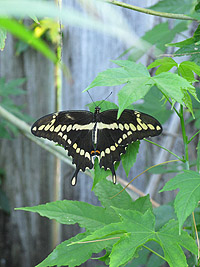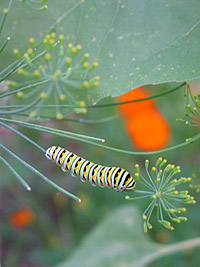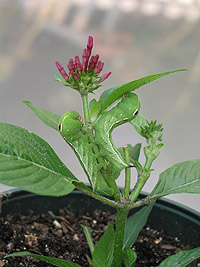
While the high temperatures outside in July and August may not agree with us humans too well, insects are a-buzz this time of year and it’s a great time to observe the many forms of insect life in your garden. Many kinds of flies, bees and wasps can be seen hunting and pollinating in the garden. Butterflies in particular are very active this time of year. Look for butterflies nectaring on flowers and laying eggs on host plants in your yard. You may see Giant Swallowtails laying eggs on Citrus trees, Black Swallowtails on parsley flowers, Spicebush Swallowtails on Camphor trees, Skippers on plants in the Pea family like Hyacinth Bean or Blue Pea Vines, Gulf Frittilaries on Passion Vine and of course, Monarchs on Milkweeds. Take care when cleaning up or removing vegetation in your garden as bigger caterpillars will wander away from their host plants to make their chrysalis on something nearby, whether it be another plant, a fence, a BBQ pit or hose bib – you never know!

Compost also loves the heat. Organic matter decomposes much faster in high temperatures due to the increased activity of the microbes, bacteria and other detrivores that work to break it down. Add generously to your compost now to ensure lots of material for your gardens this fall. Look for lawn trimmings on the side of the road as you drive around and collect them to add to your compost. Choose only those that appear fresh and that come from weed-free, healthy lawns. Such green matter is very useful in layering and covering vegetable waste from your kitchen in a compost bin. It can help keep flies, gnats and other unpleasant insects away from decomposing fruit and vegetable matter. Be sure to layer the grass clippings in small amounts. Remember that good aeration is key to composting in that the same bacteria and microbes that do all of the work in your bin or pile need oxygen to live. Large volumes of grass can mat together and form smelly, wet globs.
In the vegetable garden, Peppers, Cucumbers and Squash may all start to wind down in the intense heat. Peppers in particular may stop setting fruit, but will pick up again later in the season and can produce well into November. Side-dress with fertilizer every six weeks or so to keep them healthy in the mean-time. Smaller, more compact pepper plants like Tabasco or Hot Wax will do very well in pots if kept watered and fertilized. Okra can be the star of the veggie garden in late summer. Be sure to pick the fruit often, every other day or so, to keep the plants in production.

Pentas are one of the mainstay plants that continue to do well in our gardens through the summer heat.. Deadheading pentas can help them continue to bloom and keep them attractive all the way until first frost. One of the few pests that can attack pentas as well as peppers and tomatoes is the hornworm. These caterpillars, sometimes hard to spot due to their excellent camouflage, turn into Sphinx moths, otherwise known as Hummingbird Moths. Due to their size, they can easily be mistaken for hummingbirds, except for the fact that they fly at night. In the evenings, Sphinx moths can be observed nectaring on gingers, moonflowers and other nectar plants, as well as laying eggs on suitable host plants like pentas. Look closely for these large caterpillars if it becomes obvious that something is devouring your pentas or pepper plants. Larger caterpillars can simply be removed and thrown into the back of the garden where, removed from their food source, they will burrow and pupate to become moths.
submitted by Tammany Baumgarten
